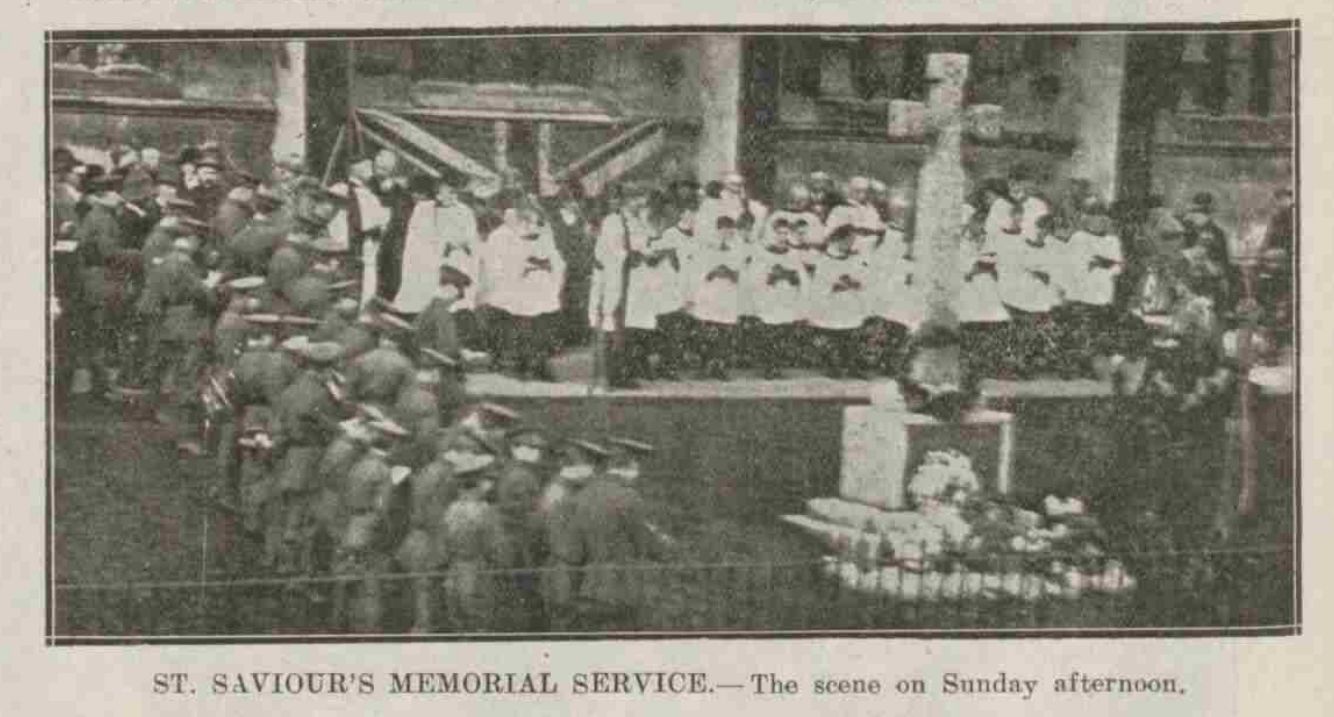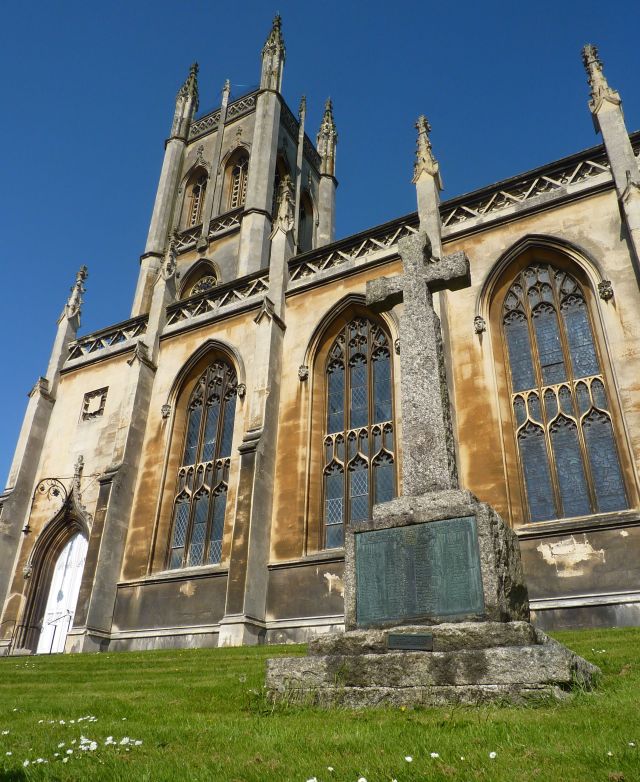The
Rector (the Rev A. Wilkinson Markby) was Chairman of the Memorial
Committee, Mr Jesse Batten the hon secertary and Mr Geo. Joliffe the
hon treasurer, while Mr F. J. Garraway was untiring in his efforts to
secure that a complete roll of honour appeared at the foot of the
cross.
THURSDAY'S CEREMONY Very
kindly proved the weather for the unveiling and a vast throng witnessed
the ceremony. By consent of the Chief of Police, traffic was suspended
in St Saviour's Road during the proceedings. The school children were
grouped on the eastern side of the cross and the slope to the
west was reserved for relatives of the heroic dead. They were many, for
the roll on the memorial numbered 84. Most of them bore beautiful
floral tributes, which were placed in front and around the cross after
its dedication. Conspicuus among them was a large wreath of laurel
leaves tied with a cluster of blood red chrysanthemums. The card on it
bore the words:
And so they passed over
And all the trumpets sounded
For them on the other side*
A
tribute of remembrance and gratitude from the scholars of St
Saviour's Schools. Most fitting that this should be so prominent,
when among the fallen honoured this day was also the Headmaster, Lieut.
George Strong. A guard of honour of the St Saviour's K.R.R. Cadets,
with rifles, stood near the memorial. On the path above were the
drummers and buglers, a dozen strong, from the headquarters of the 4th
Somerset L.I. under Bugle-Major Wiltshire. Very appropriate that they
should be there when the 'bugle' of the regiment was the badge on
several of the 'killed' from Larkhall. Mr A. E. Tucker, the organist
from St Saviour's, presided at a harmonium which led the singing. The
Archdeacon of Bath, the Rector the Rev T. W. O'Connor Parnell, and the
Rev E. Norris were present, robed, and with them was the Rev T.
Hayward, Pastor of Manvers Street Baptist Church, in his capacity of
President of the Bath Free Church Council, for it was desired that more
than one communion should be represented. The Rev Brown Tucker, or
Larkhall Congregational Church, was on the memorial committee, but he
has recently left for Devon. 'O God Our Help' was the opening hymn, and
after prayer by the Rector and Mr Powell, the Shepherd Psalm was sung.
The Rev T. Hayward read the brief lesson from Wisdom III. At its
conclusion the Rector recited the names on the parish roll of honour.
THE UNVEILING
Then
the large Union Jack which had covered the cross was removed by
Brigadier General Molesworth C.B. The General took the place of
Lieut.-Colonel H. P. P. Leigh C.B.E., church warden of St Saviour's,
one of whose sons, Capt. P. L. Leigh B.A., is included in the
roll. But Colonel Leigh left Bath early in the week for
Devonshire. After the unveiling the Archdeacon dedicated the memorial
with an impressive supplication. While the glorious hymn 'For All the
Saints' was being sung the relatives laid the floral tokens of
remembrance of their loved ones at the foot of the cross. This was the
most pathetic incident of a memorable service, and few watched it
dry-eyed. There were widows, mothers, fathers, brothers, sisters and
young children of the gallant dead laying reverently these wreaths
around the noble memorial. One of the last to place a tribute on the
greensward was the little daughter of Lieut.-Colonel Codrington, who
died of fever and starvation in beleaguered Kut.
THE ARCHDEACON'S ADDRESS
The
Ven. Lancelot Fish in his address spoke first of those whom they
honoured and saluted that day. That cross would be a perpetual reminder
not only of our Blessed Lord's redeeming love, but of the sacrifcice
made by brave soldiers. He had been reminded that the cross was in the
form of St Martin's cross. St Martin was himself a soldier, and it was
dedicated appropriately enough upon St Martin's Day. He believed that
those whom they were commemorating were worthy of having a cross as
their memorial; that they died most of them consciously, many no doubt
unconsciously, in the spirit of Him of Whom it was said 'He saved
others, Himself He could not save'. Those flowers might fade, that
granite itself might perish, but those who had lifted our poor human
nature to the loftiest possible pedestal of purpose, duty and
achievement had taken their place among the immortal. 'Their name
liveth for evermore'.
THE SIGN OF THE CROSS
Therefore
he would say to those who had just laid their loving tributes at the
foot of the cross, let them renew their faith in the after life, never
for a moment believing, as some would tell us, that the mere accident
of death could arrest or destroy their life; never accept the broken
shaft which they saw placed in the graveyards as the true emblem of
human life., but look rather to that topmost finger of the cross
pointing upwards to life beyond. In a few minutes the Last Post would
sound but he rejoiced that those who arranged that service had added
also the Reveille. If that cross were a memorial of valour, and a
comfort to those who mourned, it was a challenge to everyone there that
they should live to God and for their country as these men died for God
and for their country. They stood shoulder to shoulder, they died in
the spirit of comradeship one to another, and that was the message of
the cross. Lord Haig had written that the London cenotaph was the
emblem of national unity. Be it so. Then the cross was still more the
emblem, not only of national, but of worldwide unity. Look what it had
done that afternoon. There was never anything like it in that parish
before. There they were gathered together, with all their unhappy
divisions, just for one brief hour, sunk out of sight. What was
possible for one hour on one day was possible for all hours and for
every day, and the one hope of them drawing nearer together was that
they should all draw nearer to the Cross and to Christ.That he believed
was what these 84 gallant men would say to them if they could speak.
A
commemorative prayer by the Archdeacon and other petitions by the Rev
T. Hayward followed. One verse of the National Anthem having been sung,
the Last Post was sounded, and, after the Benediction by the
Archdeacon, the Reveille.
* Lines from 'A Pilgrim's Progress' by John Bunyan
 A rather blurry image of the 1925 Remembrance Sunday service at the memorial A rather blurry image of the 1925 Remembrance Sunday service at the memorial
|

